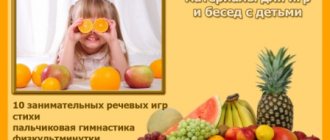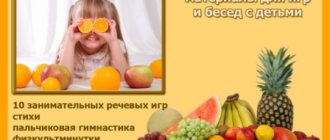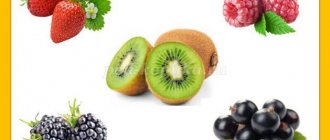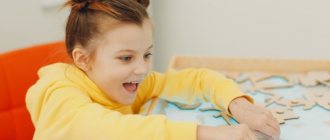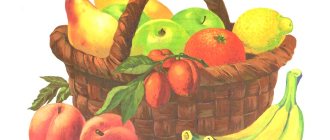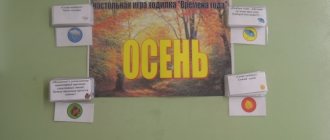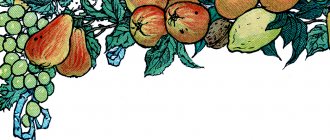Paintings on the theme “Fruit”
Ilya Efimovich Repin “Apples and Leaves”
We all know Ilya Efimovich Repin as a master of portraiture and a master of large canvases on mythological and historical themes (for example, the painting “Barge Haulers on the Volga,” which we discussed in the topic “Professions”). Still life was not the artist’s main genre, and we can say that the painting “Apples and Leaves” was created by accident. The still life, combining fruits and leaves, was created and staged by Repin for his student, young V.A. Serova. But the teacher liked the composition so much that he decided to paint such a still life himself.
A completely simple plot: six apples from the garden and a heap of leaves, but it’s all so native, Russian, realistic. The yellowish-green and red apples are not depicted as ideal “waxy” fruits, but as real, living fruits should look. It is felt that they have irregularities, dents and small spots. The simplicity of the painting makes the canvas a masterpiece worthy of the world's best halls and exhibitions.
Ilya Efimovich Repin loved nature very much. He lived 86 years and until his old age he slept in the cold, swam in the sea, never spent a day without gymnastics and ate a lot of vegetables and fruits. If Repin had a break from drawing, he found other activities for himself - riding a horse, swimming, working in the garden, planting plants or clearing snow in winter. And he did not hesitate to offer shovels to his guests, for example, Chukovsky, Mayakovsky or Chaliapin. Proper nutrition, physical activity, favorite work and the ability to live simply (without frills) are the main secrets of the longevity of the great artist. As in the painting “Apples and Leaves,” beauty is in simplicity.
Paul Cezanne "Still life with drapery, jug and fruit bowl"
"Description of Fruit"
Children: The apple is red, round in shape. The apple is big.
2.With orange skin,
Looks like a ball
But the center is not empty,
And juicy and tasty. (Orange)
(There is a picture of an orange on the board).
Educator: What is this? What color is the orange? What shape? What size? Do you think an orange is sweet or sour?
Children: Orange, round in shape...
3.It's almost like an orange
Thick skinned, juicy,
There is only one drawback -
Very, very sour (lemon)
(there is a picture of a lemon on the board).
Educator: What is this? What color is lemon? What shape is it? What size is a lemon?
Children: answer questions
4.Blue uniform, white lining,
It's sweet in the middle. (Plum.)
(on the board there is a picture of a plum).
Educator: What is this? What color is plum? What shape? What size is the plum?
Children: answer questions
5. A whole herd of horses on one leash. (Grape.)
Educator: What is this? What color are grapes? What shape? What size are the grapes?
Children: answer questions
Educator: I’m sitting on a tree, round like a ball,
Red as blood, sweet as honey. (Cherry.)
Educator: What is this? What color are cherries? What shape? What size is the cherry?
Children: Cherry is red, round in shape. Small cherry.
Educator: Well done, guys. All the riddles were solved.
Educator: Guys, how can you call an apple, orange, lemon in one word? What is this? Children: fruit.
Educator: Guys, where do fruits grow?
Children: in the trees
Educator: What are the names of the trees on which fruits grow?
Children: fruit
Educator: Where do fruit trees grow?
Children: in the garden.
Educator: What is the name of a garden in which there are many fruit trees?
Children: orchard
Educator: Well done! The Hedgehog and the Little Fox are also happy with you.
Physical school
Educator: Let's rest a little. Leave the tables and come to me. Stand in a circle. And we will put the Hedgehog and the Little Fox in the center of the circle.
Children: Go out to the teacher’s carpet and stand in a circle.
“Yesterday we walked in the garden, They walk in a circle, holding hands.
We planted currants. They depict how they dig a hole and plant a bush in it.
We whitened the apple tree with lime and whitewash. Move your right hand up and down.
We fixed the fence. Simulates hitting with a hammer.
We started a conversation: They stand facing in a circle
- Tell me, our gardener,
What will you give us as a reward? One finger is bent for each name.
I will give you lilac plums and honey pears as a reward,
The largest ripe apples, They stretch their hands forward.
A whole kilogram of cherries
This is what I will give you as a reward.
A whole kilogram of cherries, that's what I'll give you as a reward.
Music on the theme "Fruit"
Karen Khachaturyan "Cipollino - Prince Lemon"
The middle of the 20th century can be called, without exaggeration, the “golden age” of Russian animation. The artists carefully worked out every stroke, the cartoons were voiced by first-class actors, and great attention was paid to music. The music was bright, memorable, imaginative, capable of capturing a child’s imagination.
For example, remember the wonderful cartoon “Chippolino”, created at the Soyuzmultfilm studio by director B.P. Dezhkin in 1961. I still remember the bright musical compositions that sounded in the cartoon. The music for this cartoon was written by the great Soviet composer Karen Khachaturyan. 13 years later, based on this music, Karen Khachaturian created a children's ballet of the same name.
According to the composer, Gianni Rodari’s fairy tale captivated him so much that its characters lived in his imagination for a long time. “I couldn’t forget the cheerful Cipollino, the gentle Radish, the noble Cherry, the evil, loud Lemon... And for some reason, each hero now appeared to me in a dance,” admitted Karen Surenovich. Thus was born the idea of a ballet, which was embodied in a complete work in 1974. The choreography for the ballet was composed by choreographer Genrikh Mayorov.
The fate of the ballet was brilliant from the very beginning. The composer became famous throughout the world, and the ballet itself became one of the best in contemporary art aimed at children. The main roles in the ballet were performed by such famous dancers as Maris Liepa, Nikolai Tsiskaridze, Nina Sorokina, Marina Kondratieva and many others.
Some information about Karen Khachaturyan. He was born in Moscow into the family of a theater director. In 1949, Karen graduated from the Moscow Conservatory. His teachers and mentors included Dmitri Shostakovich, Sergei Prokofiev and Igor Stravinsky. Shostakovich emphasized Karen Khachaturian’s “depth of thought, masterly development of material, perfection of its implementation, beautifully flowing melodies, amazing sounds.” Karen Khachaturian composed music for symphony and small orchestras, for violin, cello and piano. Wrote five symphonies. Since 1950, Karen Khachaturian has written music for films and cartoons. The most famous of them were: music for “Cipollino” and for the film “Viy” with Natalya Varleya. In 1981 he was awarded the title of People's Artist of the RSFSR.
We invite you to watch the wonderful cartoon “Chippolino” with your children. And discuss many of the topics raised in the cartoon: mutual assistance, courage, inequality. Well, and, of course, find heroes who belong to vegetables. And the music, of course, listen more carefully to the music written by Karen Khachaturyan.
Lesson summary “Getting to know fruits”
Goal: To develop the visual, tactile, taste and olfactory sensations of children. Expand your vocabulary, develop children’s speech, the ability to listen to the teacher, and answer his questions.
Program content: Teach children to distinguish between an apple and a pear, know their names, sensory characteristics. Apple: round, smooth, hard, yellow, green or red, has a sweet and sour taste. Pear: Round, slightly elongated, yellow, soft, juicy, sweet.
Materials: A toy – a hedgehog, a basket of fruits (several pieces of each fruit), a tray, a cutting board, a knife, pictures of trees (pear, apple tree), pictures of fruits, two small baskets.
Approximate course of the lesson.
Children sit on chairs. There is a knock. - Guys, someone came to visit us. Look who it is? The teacher shows a pre-prepared hedgehog toy. Children say hello and meet the hedgehog.
- Guys, look, the hedgehog came to us with gifts. He walked through the orchard and brought us a whole basket of fruit. The teacher puts up pictures of trees and conducts a dialogue with the hedgehog - asks him what kind of trees they are, sometimes turns to the children: - Guys, maybe these are Christmas trees growing in the garden? (Children answer.) No, these are not Christmas trees, these are apple trees, apples grow on them. Apples don't grow on Christmas trees! Hedgehog, am I speaking correctly?
He tells on behalf of the hedgehog that different fruit trees grow in the garden: apple trees, pears. And that he brought fruits from these trees to show them to the children and treat them.
The teacher sits the hedgehog down and begins a sensory examination of the fruit. First, he gives apples to the children, asks them to look, stroke, smell, and press. And he asks the children what it is, seeking answers: round, hard, smooth, smells delicious, aromatic. Asks the children to repeat the signs of an apple in unison. At the end of the examination, the teacher cuts the apples into small pieces so that there is enough for all the children, the teacher, the nanny and the hedgehog. He asks them to first smell the apples and enjoy their aroma, and then eat their slices. While the children are chewing apples, the teacher names the signs: hard, sweet and sour, crunchy on the teeth, tasty. She doesn’t forget to give the hedgehog a treat and turns to him with questions. The teacher asks the children to stand up after everyone has eaten the apples and conducts a physical education session.
Physical education minute
The hedgehog hurried to his home, he carried supplies with him. (walking in place) The hedgehog jumped over the hummocks, (jumping in place) He ran quickly through the forest. (running in place) Suddenly he sat down and changed - he turned into a round ball. (sat down) And then jumped up again (stood up) And hurried to the kids (walking in place)
Then the lesson continues, the pear is examined in the same way. At the end of the lesson, the hedgehog invites the children to play. Collect apples and pears in different baskets. The teacher lays out pictures of apples and pears on the floor. The teacher and the hedgehog ask the children to collect apples in one basket and pears in another. The hedgehog praises the children and says goodbye to them.
Authors: Yuliana Vladilenovna Lebedeva, teacher; Volkova Elena Mikhailovna, teacher; MDOU general developmental kindergarten No. 37 “Romashka”, Klin, Moscow region, Russia.
The article is published in the author's edition
Game-competition “Gifts of Autumn” on the topic: “Vegetables and fruits”
Gomzyakova Irina Nikolaevna Bogatyreva Elena Veniaminovna teachers MBDOU "Kindergarten of a combined type "Teremok" Borisovka village, Belgorod region
The material was sent for publication in the All-Russian printed collection of practice-oriented materials “Preschool and primary education - modern methods and technologies of teaching and upbringing” - SEPTEMBER 2021.
COMPETITION GAME “GIFTS OF AUTUMN” ON THE TOPIC: “VEGETABLES AND FRUITS”
Goal : Generalization and systematization of children’s knowledge about vegetables and fruits.
Advertising message
General education : to develop children’s knowledge about fruits and vegetables, to consolidate the general concepts of “vegetables” and “fruits”;
Developmental : develop attention, imagination, creative thinking, creativity, activate the child’s vocabulary, introduce a new word “TASTE”, develop the ability to solve riddles, select the right word, answer questions;
Educational : cultivate the ability to listen and respect the opinions of your comrades, contribute to the formation of a children's team.
Preliminary work:
- Learning the poem “Gifts of Autumn.”
- Guessing riddles.
- Making crafts from natural materials.
Materials for the lesson:
cut-out pictures for each table on the topic: vegetables, fruits; 2 scarves; diplomas; cups with pieces of fruits and vegetables; aprons, pots and ladles; colour pencils; a bag of vegetables and fruits; 2 cars and baskets; bumps.
Event plan:
- Introductory speech by the presenter (poem, distribution into teams, introduction to the rules of the game...)
- Competition stages:
- School for the Curious
- Vegetables and fruits
- Harvest the harvest
- Tops and roots
- Fun coloring book
- Magic bag
- Transport the harvest
- Cooks
- Taster
- Summing up the results of the game, rewarding.
Progress of the event:
- - Dear Guys! Now I’ll tell you a riddle, and you try to guess it:
“I came without paints and without a brush. And repainted all the leaves.” – What do you think this riddle is about? (about autumn)
- That's right, guys. Today we all gathered here not by chance, but to talk about this interesting time of year - about autumn.
– What is autumn like? Describe it (beautiful, sad, rainy, cold...). – And she’s also generous! After all, she does not come to us empty-handed... - What do we collect in the fall? (harvest). - What is the harvest? (vegetables, fruits, mushrooms, nuts)
- Guys, our girls have prepared a poem for you called “Gifts of Autumn.” Listen to him.
1 child: Hello, Autumn! How are you? What did you bring as a gift? – I brought you vegetables, just a treat. Rich in vitamins My treat for you!
2nd child: If you go into the garden, you will find vegetables there. There are potatoes and tomatoes, pepper, cucumber, salad. If you find yourself in the forest, you will find mushrooms and berries!
3rd child: Take the baskets, collect my gifts! If you go to the garden - wow! I brought you fruits - Pears, apples and melons, I don’t know their taste more wonderful.
- Well done, girls! Guys, what is this poem about? (about fruits and vegetables) -Where do fruits grow? (in the garden) -Where do vegetables grow? (in the garden) - I see that you know a lot about autumn, about fruits and vegetables.
Guys! I propose today to arrange a game-competition and find out who knows more about vegetables and fruits. To do this we need to split into 2 teams.
(Children take turns taking out dummies of vegetables or fruits from a wonderful bag).
– We will now guess what you name your teams:
– Shine on the satin skin. Stop! There is a traffic light in the garden! It shines bright red Juicy ripe... (tomato).
The first team will be called "Tomato".
– We have teams, but who will evaluate us? Who will decide the winning team? (Jury!)
– We present to you our strict jury.
– Now let’s remember the rules of the game:
- Questions are asked to the teams in turn.
- Don't interrupt each other.
- Don't give any hints.
- For each correct answer, the Tomato team receives a vegetable, and the Orange team receives a fruit.
At the end of the game, the jury will count your fruits and vegetables. The team with the most vegetables or fruits will win. Is everyone clear? (Yes!)
– Are the teams ready to play? (Yes!) – Is the jury ready to evaluate us? (Yes!) Let's start playing!
- – The first stage of the game is called “School for the Curious.” I will ask one riddle to each team in turn. Only the team I contact responds. The rest are silent. If a team does not give the correct answer, then the right to answer passes to the next team...:
- Girlfriends live in a green hut. Like beads are round, emerald and small. (peas)
- Yellow, juicy honey fruit grows on a garden tree. (pear)
- Yellow Antoshka Spins on his leg. Where the sun stands, That's where he looks. (sunflower)
4.It is green, round, smooth. And inside it is red and sweet. (watermelon)
- Although it tastes bitter, But inside it is white and strong. And on a grater it is given to those who are sick. (radish)
- Just like a fist. Red barrel, If you touch it, it’s smooth, but if you bite it, it’s sweet (apple).
- An old grandfather is sitting, dressed in a golden fur coat. Whoever undresses him sheds tears. (onion)
- Believe it or not, we come from America. In the fairy tale we are seniors, in the garden... (tomatoes)
- I looked at the sun, became prettier and rounder. I’m not used to the cold, I’m not cabbage, but... (pumpkin)
- It’s not at all difficult to guess, anyone can guess! The leaf is elastic, emerald green and curls into the head. (cabbage)
- I am growing in the ground in a garden bed, red, long, sweet. (carrot)
- It’s unsightly, a little bumpy, but when it comes to the table, the guys will say cheerfully: “Oh, it’s crumbly, it’s delicious!” (potato)
– The second stage of the game “Vegetables and Fruits”. Each team receives cards, which they must quickly and correctly sort into two groups: vegetables and fruits. Collected - raised your hand so that we can see that you have completed the task. The team that collects it first and correctly will receive a vegetable or fruit. It's clear? (Yes!) Let's get started!
– Third competition “Gather the Harvest” . At the leader's command, you must collect as many cones as possible in one minute and put them in your container. The team that collects the most cones will win. But we collect only with our elbows, like this... It's clear? (Yes!) Let's get started!
Now let’s play the attentive game “Tops and Roots.” We will call the edible root of the vegetable roots, and the edible fruit on the stem - tops. I will name a vegetable and if it has an edible root, then you will sit down. And if the top is edible, then raise your hands up.
Carrots (roots), tomatoes (tops), onions (tops and roots) Potatoes (roots), cucumber (tops), beets (roots), parsley (tops), garlic (roots), peas (tops), pepper (tops) .
– The next stage is “Fun Coloring”. Teams receive 4 pictures. The task is to quickly and correctly color the offered vegetable, fruit, berry and mushroom on command. Is the task clear? (Yes!) Let's start!
Physical education minute.
Now let's do a little work in the garden. We got up and did everything together, in unison.
We dug up potatoes, picked cucumbers from the garden, (squats) pulled out all the carrots, (bent over) deftly cut the cabbage. And they brought you a gift in a basket from the earth. Let's continue our game.
– And for this competition ( “Magic Bag” ), volunteers from each team come to me, one from each team.
- Now I blindfold them. Assignment - I approach everyone in turn, they take out one item from my bag, feel it and name it. For each correct answer - a point. It's clear?
- Have you stayed too long, guys? I suggest you move a little, run... We move on to the “Transport the crop” stage. The teams line up behind the line. The task is to put one vegetable or fruit into your car on command, drive the car to the warehouse - basket, unload it and return empty to the team, passing the baton to the next participant, and so on until all the vegetables and fruits are in the warehouse... Is the task clear? (Yes!) Let's get started!
Competition "Cooks"
– And now you will turn into imaginary chefs and cook.
– Team “Orange”, what can you make from apples? (compote, jam, apple pies, salad)
Team “Tomato”, what can you cook from cabbage? (cabbage soup, stewed cabbage, cabbage salad, sauerkraut, cabbage pies, cabbage rolls, schnitzel, dumplings).
– This competition involves one cook at a time. On command, the cooks put on an apron, move the pan inside them, select the products they need, put them in the pan and lift the ladle up, showing us that the task has been completed. And they tell you what they have prepared. It's clear?
– This competition is called “Taster”. Who knows what this word means? Who do we call a taster?
– A taster is a person who can easily identify any object or substance by smell. For example: at a factory that produces perfume, a taster tastes - smells a new perfume and gives it a beautiful name based on its smell.
– Let’s all say the word taster together and remember what it means...
– For this competition, volunteers from each team come to me, one from each team...
- Now I blindfold them. Assignment - I approach each person in turn and offer to identify the product that is on the plate by smell. A token is given for the correct answer. It's clear? (Yes!) Let's get started!
- Our game has come to an end. And now the jury will sum up the results, count your fruits and vegetables and announce the winners...
- While the jury is counting, I suggest you play: if I name a vegetable. Then you stomp your feet, and if it’s fruit, you clap your hands. Let's get ready. Let's start!
– The floor is given to our jury.
Bibliography:
- Poems about autumn – https://www.stihomaniya.ru/2017/07/stixi-pro-dary-oseni.html
- T.A. Shorygina “Vegetables. What are they?”, Moscow, “Gnome and D”, 2007, p.83-84
- “Wonderful Box” (Russian folk songs, fairy tales, games, riddles), Moscow, “Children’s Literature”, 1988.
You can see the table of authors and learn more about the collections HERE
